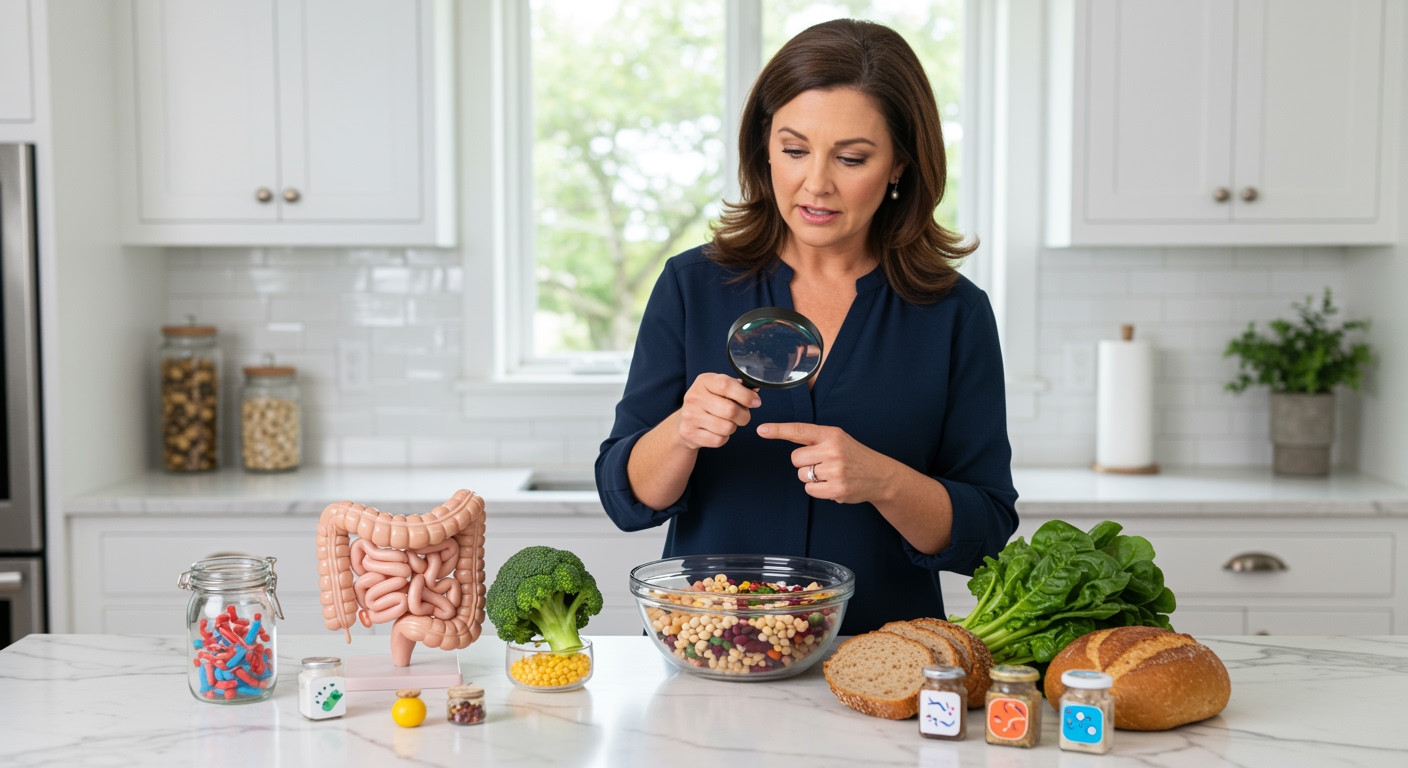✪ Key Highlight: Low fiber diets force gut bacteria to consume protective intestinal mucus, triggering inflammation in healthy adults.
Introduction
Your gut bacteria just made a shocking decision that could change your health forever.
New research reveals that when you eat too little fiber, these microscopic organisms switch from digesting plant material to literally eating the protective mucus layer that lines your intestines.
Hi, I’m Abdur, your nutrition coach and today I’m going to analyze this groundbreaking study that shows how fiber deficiency transforms beneficial gut bacteria into potential threats to your intestinal health.
What Happens When Gut Bacteria Run Out Of Fiber?
Researchers from 330 healthy American adults discovered something alarming about our gut bacteria behavior.
These tiny organisms use special tools called carbohydrate-active enzymes to break down whatever food sources they can find in your intestines.
When you provide enough dietary fiber, bacteria happily focus on digesting plant material and produce beneficial short-chain fatty acids that reduce inflammation.
However, fiber-starved bacteria become desperate and start targeting the mucus layer made of glycoproteins called mucins that protects your gut lining.
This protective barrier normally shields your intestinal walls from harmful substances and maintains healthy gut function.
Scientists developed a new measurement called the Muc2Plant ratio that tracks how much bacteria rely on mucus versus plant fiber for nutrition.
Higher ratios indicate bacteria are consuming more protective mucus, which correlates directly with increased gut inflammation markers.
✪ Fact: Gut bacteria can switch their food preferences within days based on available nutrients in your diet.
How Does This Mucus Consumption Damage Your Health?
When bacteria break down your intestinal mucus for food, they create a dangerous condition called dysbiosis.
This harmful imbalance in gut microbes has been directly linked to inflammatory bowel disease and other serious digestive disorders.
The study found that even healthy adults without obvious disease symptoms showed subclinical gut inflammation when their bacteria consumed more mucus.
This hidden inflammation occurs below the threshold of noticeable symptoms but still damages your intestinal health over time.
Your mucus layer serves as the first line of defense against harmful bacteria, toxins, and undigested food particles that could trigger immune responses.
When beneficial bacteria consume this protective barrier, your gut becomes more vulnerable to infections and inflammatory reactions.
Research shows this process can contribute to increased intestinal permeability, commonly known as leaky gut syndrome.
✪ Note: Even small amounts of chronic inflammation can accumulate into serious health problems over years.
What Does The Research Say About Fiber Requirements?
Expert Hope from the research team explains that fiber intake should be slightly more than what your existing gut bacteria are asking for.
This means you need to gradually increase fiber consumption while drinking plenty of water to avoid uncomfortable gas and bloating.
Studies comparing different populations reveal dramatic differences in gut health based on fiber consumption patterns.
People in rural areas and Mediterranean regions who eat fiber-rich diets have completely different microbial communities compared to those in developed areas.
Higher fiber intake consistently correlates with greater microbial diversity, which researchers consider a key marker of gut health.
A study published in mSystems demonstrated that even short-term fiber increases of about 25 grams per day for just two weeks can reshape gut microbiome composition.
This dietary change specifically increased beneficial bacteria like Bifidobacterium and Lactobacillus that specialize in fiber degradation.
✪ Pro Tip: Start with an extra 5 grams of fiber daily and increase gradually over several weeks to avoid digestive discomfort.
Which Foods Can Redirect Your Bacteria Back To Healthy Digestion?
The key to protecting your gut lining lies in providing diverse plant fiber sources that keep bacteria busy with healthy digestion.
Vegetables, fruits, whole grains, legumes, nuts, and seeds all contain different types of fiber that feed various bacterial species.
Research shows that fiber fermentation by gut microbes produces beneficial short-chain fatty acids and creates more robust microbial ecosystems.
These fatty acids serve as fuel for your intestinal cells and help maintain the protective mucus barrier that bacteria would otherwise consume.
Different fiber types support different bacterial functions, so variety becomes crucial for optimal gut health.
Soluble fiber from oats, beans, and apples feeds bacteria that produce anti-inflammatory compounds.
Insoluble fiber from vegetables and whole grains provides bulk and supports beneficial bacteria that maintain intestinal structure.
✪ Fact: Your gut bacteria can adapt to new fiber sources within 24-48 hours of dietary changes.
The Bottom Line
This research proves that inadequate fiber intake forces your gut bacteria to literally eat the protective lining of your intestines, creating inflammation even in healthy people.
Your gut bacteria will always find something to eat, and you get to choose whether they feast on fiber or your intestinal protection.
I would love to hear your thoughts about this research and any questions you might have about improving your gut health through fiber intake in the comment section below.
References
At NutritionCrown, we use quality and credible sources to ensure our content is accurate and trustworthy. Below are the sources referenced in creating this article:
- mSystems Journal: Fiber intake modulates the association of alcohol consumption with beta diversity and Lachnospiraceae
- PMC: The Role of Dietary Fibers in Regulating Appetite, an Overview of Mechanisms and Weight Consequences
- News Medical: How fiber intake shapes your gut microbes’ digestion strategy
- American Heart Association: Gut Microbiome and Cardiovascular Disease
- Stanford Longevity Center: What is fiber and why is it important for the microbiome?





